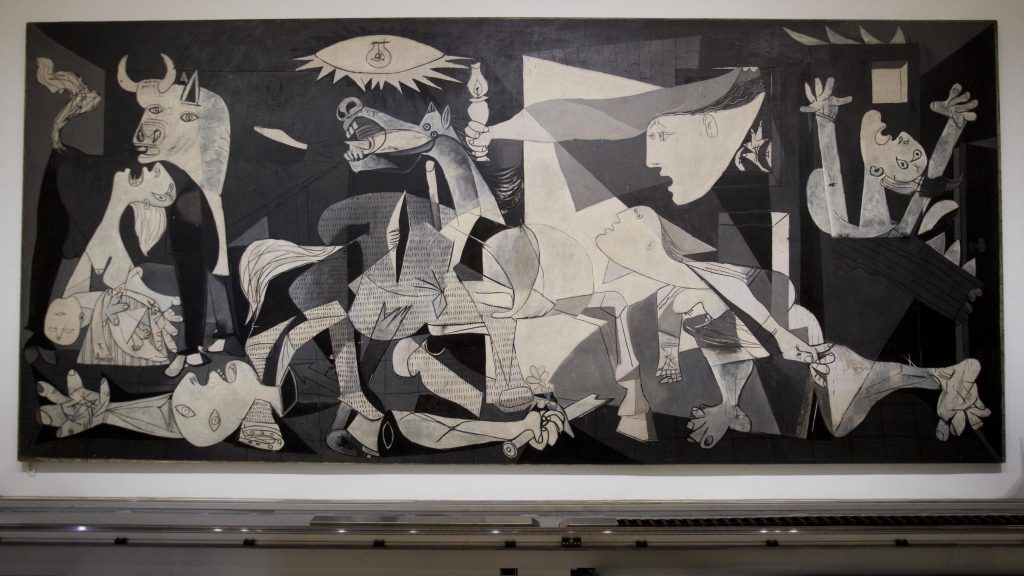


Goal- Create an uncomfortable feel of Chaos, confusion and violence
Solution - On first glance, Guernica’s composition appears confusing and chaotic; the viewer is thrown into the midst of intensely violent action. Everything seems to be in flux. The space is compressed and ambiguous with the shifting perspectives and multiple viewpoints characteristic of Picasso’s earlier Cubist style. Images overlap and intersect, obscuring forms and making it hard to distinguish their boundaries. Bodies are distorted and semi-abstracted, the forms discontinuous and fragmentary. Everything seems jumbled together, while sharp angular lines seem to pierce and splinter the dismembered bodies. However, there is in fact an overriding visual order. Picasso balances the composition by organizing the figures into three vertical groupings moving left to right, while the center figures are stabilized within a large triangle of light
Goal- Create a experience of reading current events through newspaper visuals or documentary
documentary
Solution -Picasso chose to paint Guernica in a stark monochromatic palette of gray, black and white. This may reflect his initial encounter with the original newspaper reports and photographs in black and white; or perhaps it suggested to Picasso the objective factuality of an eye witness report. A documentary quality is further emphasized by the textured pattern in the center of the painting that creates the illusion of newsprint. The sharp alternation of black and white contrasts across the painting surface also creates dramatic intensity, a visual kinetic energy of jagged movement.
Also, Picasso didn’t want to distract from his message by including color, so he eventually made it all stark white, black, and gray. Originally, he’d painted a red tear on the woman’s face, but ultimately decided not to keep it.
Goal- Convey the abhorrence through images and symbols
Solution - There has been almost endless debate about the meaning of the images in Guernica. Questioned about its possible symbolism, Picasso said it was simply an appeal to people about massacred people and animals. ”In the panel on which I am working, which I call Guernica, I clearly express my abhorrence of the military caste which has sunk Spain into an ocean of pain and death.” The horse and bull are images Picasso used his entire career, part of the life and death ritual of the Spanish bullfights he first saw as a child. Some scholars interpret the horse and bull as representing the deadly battle between the Republican fighters (horse) and Franco’s fascist army (bull). Picasso said only that the bull represented brutality and darkness, adding “It isn’t up to the painter to define the symbols. Otherwise it would be better if he wrote them out in so many words. The public who look at the picture must interpret the symbols as they understand them.”
Goal- Symbolize the flame on the sky due to bombings and technological advancement
Solution - Picasso didn’t illustrate the bombing in a realistic manner, and there aren’t any bombs depicted in the piece. Instead, Picasso uses a light bulb surrounded by a glowing halo of luminous spikes. This symbolizes the flames that tore apart the sky during the bombing. It is also the only object that depicts the 20th century talking about the technological advance.
Goal- Show the suffering inflicted on the Spanish people by the dictators and German bombers
bombers
Solution - Just under the light bulb the viewer’s attention is drawn to a horse. The animal has been disemboweled by an arrow and is howling in pain. This is emblematic of the suffering inflicted on the Spanish people by the dictators and German bombers. Picasso additionally includes a subliminal skull, formed by the nose and teeth of the horse
Goal- Depict the death and suffering caused by war
Solution - With her head and eyes rolled back, the woman holds her dead baby whilst helplessly reaching out towards the sky. This depiction is reminiscent of portraits of Dora Maar, which Picasso nicknamed “the woman who cries”. Another woman is also shown to the right of the painting: her arms are also raised and her mouth frozen mid-scream. She is surrounded by flames, which are symbolized by the tips of triangles which allude to the explosions caused by the bombs.
Solution - Underneath the horse are the shattered remnants of a dead soldier; in the grip of the hand on his severed arm is a broken sword out of which a flower grows. On the palm of his other hand signs of the stigmata of Christ are visible, indicating martyrdom. He is the only man and the only figure lying down in the painting. He has been dismembered yet still holds his broken sword, which is emblematic of his heroic yet futile attempt to fight against the terror. A ghostly flower grows by the fighter’s hand, signifying hope despite the bloodshed- much like the shrouded light provided by the woman’s kerosene lamp.